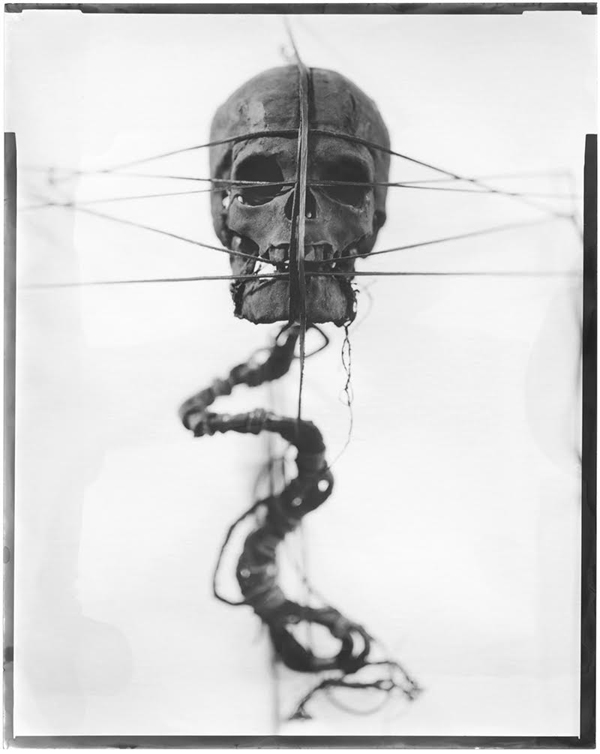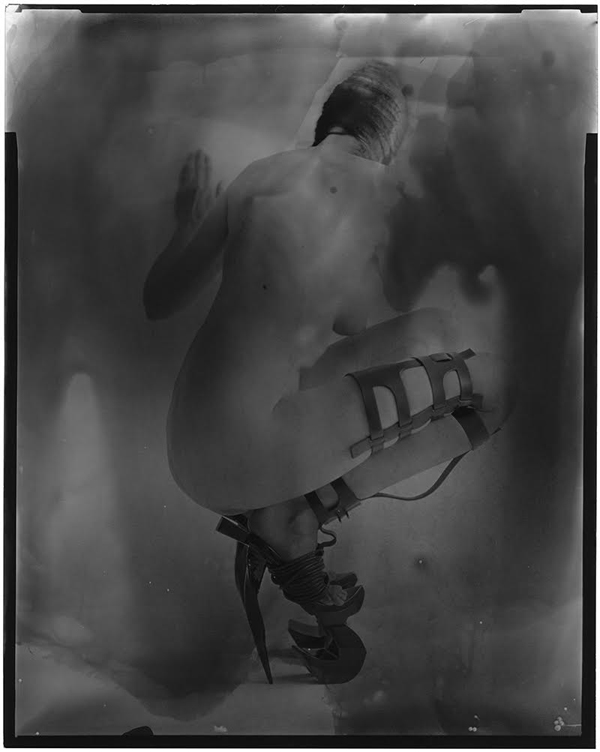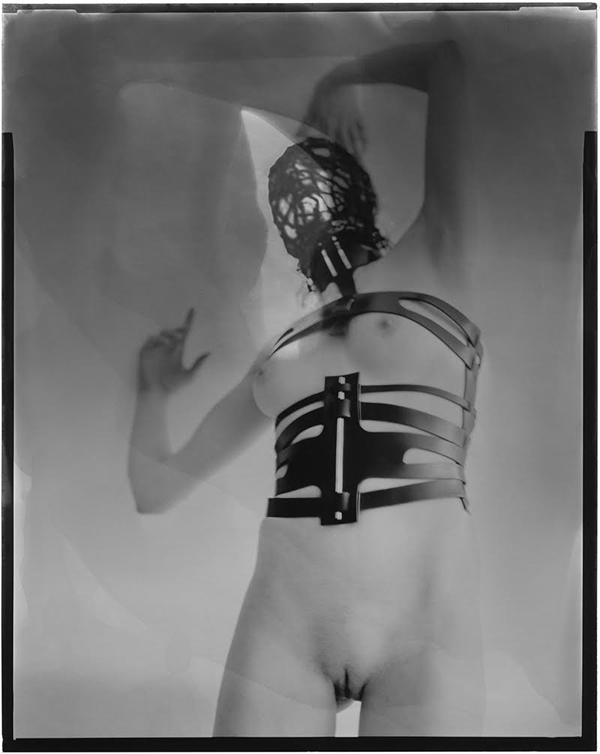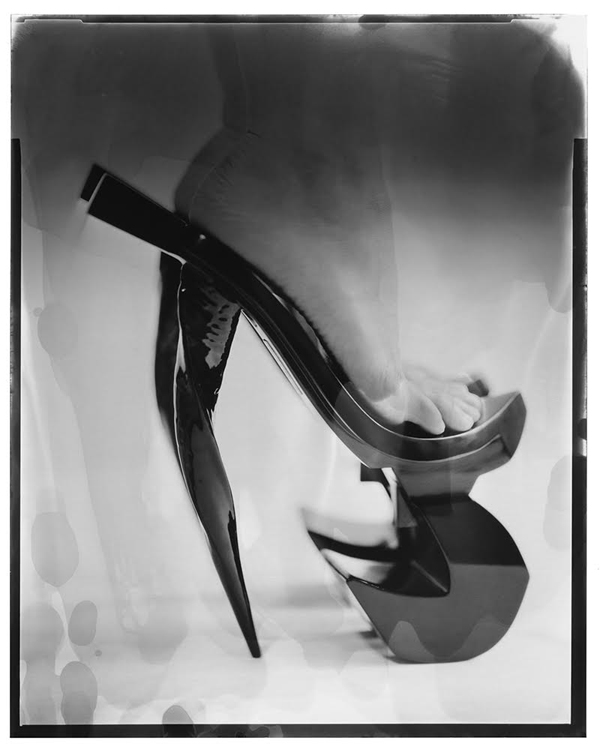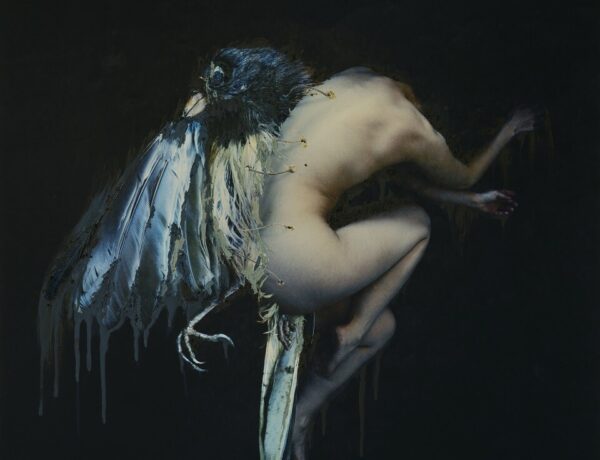At roughly the same frequency as spontaneous combustions, there emerges an artist who will leave an indelible brand on the rump of humanity. In the case of artist, poet, designer, and “emotional pornographer” Aoi Kotsuhiroi, it’s less of a brand and more of a scarification: She patiently tears strips of flesh from the art world’s inbred, autosarcophagic derriere in a design both brutal and sublime.
I’ve been obsessed with Kotsuhiroi’s work since before I was legal, after stumbling upon pictures of her shoes, what she calls “body objects” or “feet objects”—rapture/torture contraptions strangled in strips of dead animal and human hair, elevated by mini Brutalist apartments, and graced with saber-toothed heels. They make the so-called fetish shoes by Pleaser and Devious look like Uggs. In fact, it seems almost obscene to be name-dropping such brands within a 100 mile radius of the France-based Japanese artist’s haute fétiche designs.
The art world’s S&M Elena Ferrante is the definition of arcane. She has done a handful of interviews, mostly with niche magazines and art blogs. She only does interviews by email, she told me, and her answers are always sphinx-like, sometimes amusingly, sometimes frustratingly so. In one, she said her celebrity client is the devil (who “lives in Japan actually”), declared her favorite materials to be “the escape,” and nonchalantly revealed that she’s a “ghost.”
Given her disdain for the fashion industry, it is unlikely she will ever become a fashion designer. But if she did, she would eviscerate every couturist today, with Michele Lamy being the only person worthy to wear her work.
We caught up with Aoi Kotsuhiroi to talk self, dystopia, destruction, and commodification. She has also graciously offered a preview of her upcoming poetry/photo project DYSTOPIA, the first movement of her larger project PROPHECY, to be debuted at the end of May.
Aoi, it is truly an honor to interview you after admiring your art from afar for years. If you would be so kind as to indulge me, please introduce yourself and your artwork to beautiful.bizarre and its readers…from the perspective of someone who repulses you, or from someone you repulse.
The “I” of the « other » or taking the place of someone who is not yourself and talking about yourself. It is a form of waking nightmare and searching in the consciousness of this “other”, his thoughts about you. A form of combined interrogation of neurosis. A bad mirror whose reflection never ceases to be terribly blurred. Imagining the other talking about you and transcribing his sentences, being postponed, that means a list of incalculable things, for this or that, out of fear, jealousy, for mood, for no reason, just because we are in another room and that the door does not open. I do not want to put myself in the place of another one to say what I am or what I’m not.
It is clear, from looking at your work, that you have evolved significantly from your beginnings. An elegantly primal, punk-imploding, kinbaku-wrangling Pokemon, if you will. Is it possible for you to identify distinct “periods” of your work, and if so, what are they? How would you describe your artistic metamorphosis and what are the forces that have influenced this growth?
« Periods » are passages, forms of necessities of understanding and experiences. The experience of these periods do not always leaves a beginning and an end, a change… It is an ongoing thread made of waves, breaks, repairs, questionings and expectations. The work is a functioning of crisis, anger and forgetfulness; it does not follow a well-established pattern as an assembly plan for a furniture kit. The concept of environment, that is to say a form of biotope that allows the organic-poetic thought to grow, to take root, to look for nutritious links, remains very fragile. Metamorphoses are molts, very necessary abandonments, it is to be critical and lucid in front of the mirror and watching this outside of us and undo once again what is wrong.
Please tell us about your upcoming project, Prophecy, and its first movement, Dystopia (a preview of which we have excerpted below and which Aoi tells me will debut towards the end of May). What does the word “dystopia” mean to you? Are we currently in a dystopia? If not, how close are we?
Prophecy is a conjunction of realities and stories, a title for movements and noises. The burden of reflection on Prophecy and its object-word content weighs on us, there is anguish and hope, vision of the announcement of what is, a now in a strange balance, a kind of landmark that never ceases to escape. Dystopia is the first movement, as a search, an excavation with traces and clues, a change in odor as a climate change, something inevitable, a chemical balance that is no longer the same.
The Dystopia is a disease, a form of virus contracted in unknown circumstances, it affects our memories, undresses our consciousness, fueling the gene of lucidity and thus a form of suffering in relation to perception. Each thing can take a turn to taste this fruit that cries hope. Be carrying Dystopia involve a different system of life, since the Dystopia exists it means that there is a sort of reason for its existence, a fertile ground that allowed it to take root and grow. The trace or strain of Dystopia is extremely difficult to know and find. Its ability to adapt and mutate to the environment is extremely important, it survives very impressively and until today no system has been able to eradicate it.
Prophecy is a series of 4×5″ view camera photographs, including sculptures/objects in conjunction with body/matrix. These images are in articulation with the poem.
Poem translated from French by Aoi Kotsuhiroi. This is an excerpt of PROPHECY (first movement: DYSTOPIA); for the full piece please visit the artist’s website.
PROPHECY
FIRST MOVEMENT
DYSTOPIA
We are packs
of vanity-thirsty dogs roaming time
Our consciousnesses crashed on the highway
like puddles of neglected lives
that flow in the midst of the landscape
of a resting area
Our empty maws by despair
are seeking a last day drop to breathe
light without fatigue
This sense of self
a color mixing
that doesn’t mean much
Then don’t forget to keep
a sad shape for memory
and remember of course to replace
the water of the flowers to prevent sadness
from fading
Reversed angels’ skin
doesn’t shine anymore and clay dogs
have dried their tears
A misfortune nest for the bird
in disgrace
You seek to understand the intention
of your tormentors
there is none
This quality night
in a quality suit
men murdering our hopes
This memory of oblivion when shadow
breathes
appearances
a garment
Blind in Winter
get out of the labyrinth
We should be able to say fuck but with
beauty
Death noise
It’s dark when I cry and my tears
breathe a death noise
In the text portions of your artwork, you have often written in the first person. How much of this is explicitly autobiographical, and how much of it is toying with and disrupting the ideas of identity and self?
The geography of the ‘self’ is complex, our own identity in its inner nature, then external, often reveals an ambiguous form, a ground hard to define, changing and contradictory. Being in the autobiography, real or fictional, is to be in possible reference points, a stability of living. I am not what I am; my name is a « nom de guerre », a built identity of existence, an identity that is no longer in affiliation with compulsory social or family relationship. Building one’s own name is building our own gender, our own character, our own truth; it is to shape our own self, to return to our own independence and to determine our own form of life. Our self, as a condition of our own reality. I’m the surrogate mother of my own self, devourer of my nights in the gaping hole of an injured destiny. I am a man in the uncertainty of the day, looking sounds of heat like locked memories.
This is an interview for an art magazine, so it might be a wee biased, but how much of an artist to we have to understand to appreciate or understand their art? Are we getting too obnoxiously meta here?
To understand an artist or to understand his work is a personal story where each case is a special case. I do not know if there is a limit point not to exceed in order to understand the work of an artist and understanding, or at least grasping, a part of his life to access something less superficial or formal in his work. It’s a complex relationship, it is difficult to know where the intimate and the external border begins. This dialogue is a dialogue to build, or not.
In past interviews, you have expressed your distaste for the fashion industry, branding and commercialization. Can you elaborate on this aversion and has it abated at all?
This industrial system, like any mass production system is based on the outlines of exploitation. Thereby, its first relation is profit, which removes any notion of quality, attention, relevance, and research… this system bathes in a general mediocrity and imposes its economic and material weight, its own choices and reasons. But this is a form of cliché that is accepted because a compromise of satisfaction exists, even if this compromise is mediocre. Making different choices is possible, but very few people can do it or feel like they want to do it.
Additionally, you, like other artists, also use social media and the name “Aoi Kotsuhiroi” carries quite some weight. What are your thoughts on the inescapability of social media and branding, especially in the art world and in 2016? How can artists reconcile their creativity and success with such banalities without losing their artistic integrity?
Social media are streams where circulates a form of metadata. Like any language, it requires an element of magma, of confusion, of contradiction, and understanding it and grasping it is not always easy. Translation is the sort needed to find a kind of balance and a use of the environment. In this navigation of flow, reconnaissance characters are important, as benchmarks beacons where we can cling and start building something. The question of labeling enters into transactions with these notions of benchmark beacons, it is by that to position, to classify and seize the content. It is very difficult to avoid the label since it stabilizes a position that allows a human order to know where you are. We must therefore be aware of it and work with it.
Each individual reacts differently to its environment based on the characters and choices, orientations will inevitably vary. Integrity and reconciling something are a difficult arrangement, why doing it? What are the reasons, circumstances, issues, remorse and pitfalls?
Have you ever felt pigeonholed or reduced into a particular Aoi Kotsuhiroi-stereotype? Semi-relatedly, have you transcended the individual and become a concept in the minds of your audience? Can you avoid either of these as you become more famous?
I don’t think so, an important form of physicality exists in my work and this puts aside a uniquely conceptual perception. The material of development in which my relationships exist tackles before all things a notion of the Sensible and the Affect. The « reason » character where the transcendence of the individual who had transformed into a kind of concept does not attract me. I need this emotional sweating, to capture the experience of time.
All this is a matter of choice, both of refusal and acceptance. You just have to decide what you want to do or not, and then the question of experience is important, as a kind of ability to see better, to grasp a form of detachment not to clutter and continue to act.
Continuing on this vein, you have referred to some of your work as “body objects” and “feet objects,” and you have played with concepts of fetishization, fixation and commodification. At what point does art become fetish and/or product—and vice versa?
Man in his original essence has this need of fetish as a both spiritual and emotional instrument. The fetish object is the witness of our emotional and relational writings. Our lives translate by their fetish traces, our courses of memory. The fetish object is not an object of the produced Art. It is a surpassing, by its perception and relation, its position of condition and its environment determines it as a wholly situation in a specific identity. The nature of its function keeps it away from the decorative and the demonstrative, its commitment not to be a product or a common and vulgar cliché is an important distinction that has to be made. Amalgams and confusions of perceptions are forms of reading and meaning mediocrity. The fetish object is a story of structure and organ of warrior poetry.
But all this is only the outlines, we should, to make the analysis and reflection further, determine specific examples of fetish objects, Art objects, a condition of contextualization, and the question: “who watches what?”
Has anyone ever approached you about turning your designs into large-scale productions or a brand? If so, how did you respond and why did you respond as you did?
I did not see anything happen, just some details of no great importance. Faced with the details I just said “no” because it had no interest.
If you could abandon this world for another, would you? And what would it look like?
The concept and perception of abandonment would be a kind of renunciation, of neglected thing, a form of bankruptcy, of escape, of failure and sadness. We capitulated because we have failed to understand what we are and what we did. Our incompetence and our cowardice are there, and we start to reproduce the same pattern. I don’t want to run away or to give up; I want to build a labyrinth where the exit exists.
And to end on a truly nihilistic note, what is the most beautiful and terrible way someone or something can self-destruct?
I do not think the concept or field of nihilism is a necessary and appropriate condition. The state of lucidity is already an important nature of perception and understanding. This lucidity implies that gaze of nudity and doubt on what surrounds us and touches us. The questioning, the define sense, the position of the will, the writing of a here-after, the pattern of history and experiences, the place of a spiritual made to stabilize our anxieties of life, the choice to leave, to go in human dignity, to fall into oblivion in the distance of the night carried away by our memories.








